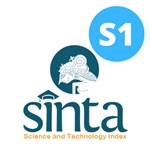MANAJEMEN RISIKO PADA LABORATORIUM BIOFARMASETIKA DAN ANALISIS FARMASI FAKULTAS FARMASI UNIVERSITAS AIRLANGGA
Downloads
The laboratory is a place of activities for research, education and product quality test. The laboratory is also a place to conduct experiments and research that has a source of danger and can cause work accidents. The research objectives are aware of risks and hazards in the laboratory, hence the need to identify hazards, risk assessments, and risk control. Data collection method used is observasional, based on the analysis of properties and data analysis hence this research including descriptive research. In review from the time of the study including cross sectional. The sample of this research is 6 laboratory personnel in 2 laboratories. The data used are the primary data from the observation, interview and questionnaire and secondary data obtained from the Faculty of Pharmacy. The results of the study can identify as many as 8 hazards. In the risk assessment obtained the highest danger level is high risk. High risk risk level of 3 hazards ie HCl solution spills, nitric acid spills, sulfuric acid spills. This laboratory is still quite dangerous because it is still found high risk. The existing risk control in the laboratory is well implemented and needs to be improved by the use of Personal Protective Equipment (PPE).
Keywords: hazard identification, risk assessment, risk control
Amanah, I., Nugraha, W., Priyambada, I., 2011. Identifikasi Bahaya Dan Penilaian Risiko (Risk Assessment) di Laboratorium Studi Kasus di Laboratorium Lingkungan Fakultas Teknik Universitas Diponegoro. Repository journal UNDIP.
http://eprints.undip.ac.id/42213/ [Diakses Pada 14 Juli 2017]
AS/NZS 4360 Tahun 2004 Tentang Risk Management Set. Sydney: Standarts Australia International Global.
Di Serio, L.C., De Oliveira, L.H., Schuch, LMS., 2011. Organizational Risk Management – A Case Study in Companies that have won the Brazilian Quatity Award Prize. Journal of Technology Management & Innovation Vol. 6 No. 2, p. 230-243. http://www.jotmi.org/index.php/GT/issue/view/issue22 [Diakses pada 14 Juli 2017].
Fakultas Farmasi Universitas Airlangga., 2015. Buku Panduan Pendidikan Program Studi Pendidikan Apoteker. Surabaya: Universitas Airlangga.
Imamkhasani., 1998. MSDS : Lembar Data Keselamatan Bahan Vol. 1. Bandung: Pusat Penelitian Kimia Lembaga.
Labombang, M., 2011. Manajemen Risiko dalam Proyek Konstruksi. Jurnal SMARTek, Vol 9 No 1 Pebruari 2011 ; 39-46. http://jurnal.untad.ac.id/jurnal/index.php/SMARTEK/article/view/618/536 [Diakses pada 20 Juli 2017].
Notoatmodjo, S., 2005. Metodologi Penelitian Kesehatan. Jakarta : Rineka Cipta.
Peraturan Pemerintah Republik Indonesia Nomor 50 tahun 2012 tentang Penerapan SIstem Manajemen Keselamatan Dan Kesehatan Kerja. Jakarta: Kementrian Tenaga Kerja.
Ramli, S., 2009. Pedoman Praktis Manajemen Risiko dan Perspektif K3 OHS Risk Management. Jakarta: Dian Rakyat.
Tarwaka., 2008. Keselamatan dan Kesehatan Kerja Manajemen dan Implementasi K3 di Tempat Kerja. Surakarta: Harapan Press.
Undang – Undang No 1 Tahun 1970 Tentang Keselamatan dan Kesehatan Kerja. Jakarta: Kementrian Tenaga Kerja.
Undang – Undang No 13 tahun 2003 Pasal 8 Ayat 2 Tentang Ketenagakerjaan. Jakarta: Kementrian Tenaga Kerja.
Widiantoro, F., 2013. Identifikasi Bahaya, Penilaian Risiko dan Upaya Pengendalian di Laboratorium Material dan Teknik kedokteran Gigi (Penelitian Di Fakultas Kedokteran Gigi Universitas Airlangga). Skripsi. Surabaya: Universitas Airlangga.

In order to be accepted and published by The Indonesian Journal of Occupational Safety and Health, Author(s) who submit an article should complete all the review process. The copyright of received articles assigned to the The Indonesian Journal of Occupational Safety and Health and Department of Safety and Health, Universitas Airlangga as publishers of the journal. The intended copyright includes the rights to publish articles in various forms (including reprints).
The Editorial Team of The Indonesian Journal Of Occupational Safety and Health and Department of Safety and Health strive to ensure that no errors occur in the articles that have been published, both data errors and statements in the article.
Users of this website will be licensed to use materials from this website following the Creative Commons Attribution-NonCommercial-ShareAlike 4.0 International License. No fees charged. Please use the materials accordingly.
------------------------------------------------------------------------------------------------------------------------------------------------------------------------------------------
Attribution ” You must give appropriate credit, provide a link to the license, and indicate if changes were made. You may do so in any reasonable manner, but not in any way that suggests the licensor endorses you or your use.
NonCommercial ” You may not use the material for commercial purposes.
ShareAlike ” If you remix, transform, or build upon the material, you must distribute your contributions under the same license as the original.







 How to Submit Articles in OJS
How to Submit Articles in OJS

























